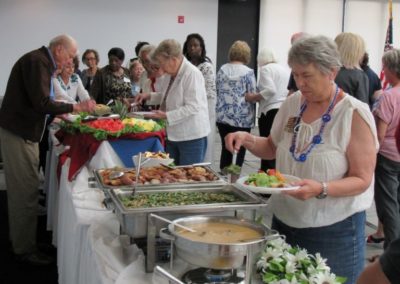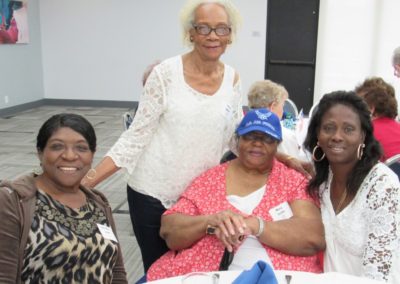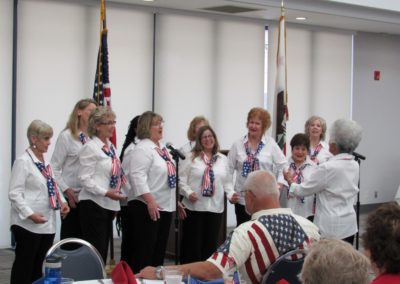August 2019
Honoring Yesterday – Protecting Tomorrow
Vol. 50, No. 8
What’s Inside
- President’s Message
- August General Membership Meeting
- The Cost of Retiree Health in 2020
- Pension Facts
- In Memory of Kay Ryan
- Members Share
- Save the Date Coming Home 2019
- Where Are They Now?
- Recent Events
- Board Member Profile John McTighe
- County Employee Investment Club
- Save the Date SDCCU
- RESDC Day at the Padres
- Flag Day / Independence Day Luncheon Photos
- Welcome New Members
August Calendar of Events
Tues., August 6, 9:30am
RESDC Board of Directors Retreat
8825 Aero Drive, Suite 100
Thurs., August 15, 9:00am
SDCERA Board of Retirement Meeting
2275 Rio Bonito Way, Suite 200
Weds., August 28, 10:00am
RESDC General Membership Meeting
Glenner Centers’ Town Square® Tour & Presentation
2765 Main St., Suite A, Chula Vista, 91911

 Thurs., September 12, 12:40pm
Thurs., September 12, 12:40pm
RESDC Day at the Padres
San Diego Padres vs. Chicago Cubs
Tickets are selling fast!
More info & buy tickets →
![]() View the NETWORK
View the NETWORK
as a printable PDF
Are you on social media?
Stay connected with us!![]()
![]()
![]()
Quote of the Month
” We make a living by what we get but we make a life by what we give.”
▪ Winston Churchill
President’s Message
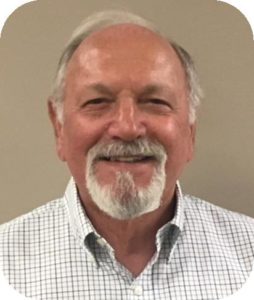
By John J. McTighe
My wife, Teresa, and I recently returned from a three-week vacation in France in celebration of our 50th wedding anniversary. We love to travel and are determined to do as much as we can while our health allows us to. Being 70 and 73, we found this trip pushed the limits of our stamina. The last time we spent any extended time in France was 17 years ago when we spent a week in Paris with our two daughters and their husbands.
A few years ago, we decided that for our 50th anniversary we wanted to nostalgically recreate some of those experiences with them and our now four granddaughters. To make this happen, we had to coordinate with school calendars and planned summer camps. We set the date for the five-day Paris portion of the trip well in advance and arranged the rental of a multi-suite guest house in a quiet neighborhood outside the center of the city. After our five-day family time together, Teresa and I spent a couple more nights in Paris and then picked up a rental car, spending the next 13 days driving a large loop from Paris to Normandy, then to picturesque Mont Saint-Michel, over to the chateaux-filled Loire Valley, down to the medieval villages of the Dordogne region, further southeast to enchanting Provence, then back north through the wine country of Burgundy and finally back to Paris for our flight home.
Along the way, I gained some insights from our travel that you might find helpful if you are contemplating independent travel in a foreign country for an extended period. First, and probably most obvious, it really helps if you speak the local language. At a minimum, it’s helpful if you’ve learned some basic words and phrases in advance of your travel. These include greetings and knowing how to ask where the bathroom (or market, hotel, train station, etc.) is located. There is a smartphone application called Google Translate that can help somewhat in bridging the language gap. Not only will it give you the correct word or phrase, you can listen to how it should be pronounced, and you can use it with your phone’s camera to translate written words on a menu. I consider it a must-have for foreign travel.
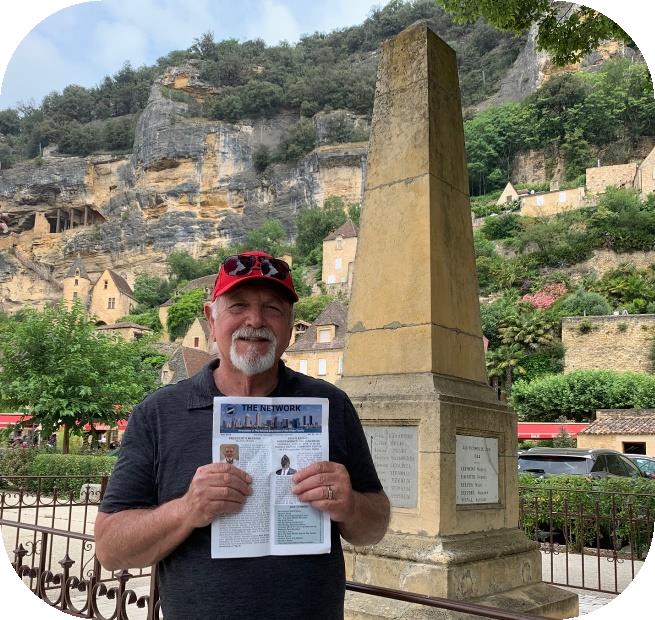
RESDC President John McTighe “networking” (i.e. taking a photo with the NETWORK in interesting places) in La Roque-Gageac, France with the troglodytes (aka people who used the natural sheer cliffs and massive caves to build fortresses and other habitation throughout the centuries).
Second, it helps to figure out the money system and be aware of how much you are spending. Travel in most of Europe is simplified by the fact that most European countries have adopted the common currency of the Euro. Like the dollar, the Euro uses a decimal system with currency denominations of 5, 10, 20, and 50 Euros, and coins for smaller amounts. Like in the U.S., ATMs are almost everywhere, so it’s easy to use your U.S. debit or credit card to withdraw cash in Euros. But you need to be aware of the fees you may have to pay to do so. Many U.S. banks and credit unions issue cards that do not charge foreign transaction fees, but many do, so make sure you have a card that doesn’t, or you’ll be paying an extra 3% or more on all withdrawals and charges you make.
Third, driving in Europe can be a challenge, but understanding a few basics helps. Be sure to observe all street and directional signs. It can be confusing at first, but most signs will be self explanatory. Speed limits are always red numbers on white backgrounds with red circles around them. A white horizontal dash within a red circle means you can’t go there. Anything with a diagonal slash through it means it’s the opposite of what’s under the slash. Then there’s the roundabouts…everywhere. Roads in France seem to all come together in a circle and it’s your job to figure out which one you want to take to get out of the circle in the direction of your destination. Once again, there’s help in the form of another set of smartphone applications. There are several that can help in this regard, but my preferred one is Waze. Not only did it tell me the time and distance in miles to my destination, but it told me which exit to take from each roundabout.
Another app, Google Maps, was most helpful when we were in the city of Paris to navigate the Metro system. Paris has one of the most extensive transit systems in the world. What I found most helpful was how Google Maps could tell me which Metro line to take and which one to change to in order to get to where I wanted to be. After typing in the address or name of the location I wanted to get to, Google Maps showed me the nearest Metro station, the shortest route to walk there, the Metro line to take, the station to get off or change at, and finally the shortest walk from the last station to my destination.
I’ve run out of space for this month, but I’ll share some more observations and tips about international travel in a future column. In the meantime, I look forward to seeing some of you at our upcoming General Membership Meeting at the Glenner Centers’ Town Square on August 28th. ◾
 August General Membership Meeting
August General Membership Meeting
Glenner Centers’ Town Square® Tour and Presentation
Wednesday, August 28, 2019
Tour begins at 10:00am. Continental breakfast at 10:45am.
Glenner Centers’ Town Square®
Tour and Presentation
2765 Main St., Suite A
Chula Vista, CA 91911
Caregiving for Alzheimer patients can be overwhelming and it is important to know what resources are available. Many families entertain hiring care within the home, and others look into residential placement. There is, however, an often overlooked yet extremely valuable and relatively affordable option of adult day care. Town Square® is the nation’s first Reminiscence Therapy Day Center in the nation and has been designed to replicate a small 1950s town in an effort to facilitate reminiscence. Please join us to tour the Glenner Centers’ Town Square®.
Directions: Drive south on I-5, exit Main Street, turn left onto Main Street. 2765 Main St. is on the right.
RSVP requested. Visit: www.resdc.net/events or call 619-688-9229. ◾
The Cost of Retiree Health in 2020
By Stan Coombs, Director
 Americans have a 50/50 chance of reaching 80 years of age, it’s been reported, but a 1% chance of reaching 100. Makes one want to spend those years in good health, and the price of health, not unexpectedly, continues rising for San Diego County retirees.
Americans have a 50/50 chance of reaching 80 years of age, it’s been reported, but a 1% chance of reaching 100. Makes one want to spend those years in good health, and the price of health, not unexpectedly, continues rising for San Diego County retirees.
The San Diego County Board of Retirement spent about 15 minutes of their June 20th meeting on Agenda Item No. 12, “Approval of Calendar Year 2020 Retiree Health Insurance Plan Rates.” The Board approved the new rates unanimously.
The issue came to the Board in a memo from SDCERA Chief of Staff Rebecca Wilson, advising that Cheiron, the Board’s health consultant, had concluded their analysis and negotiations with the three sponsored health providers, Kaiser, United Health Care and Health Net. Cheiron presented the results of their labor in a separate three-page memo, and Cheiron staff representative, Michael Schionning, elaborated in a soft voice that a fickle audio system wasn’t able to modulate for older listeners in the audience. But it was worth straining to hear.
Section 9010 of The Patient Protection and Affordable Care Act (ACA), commonly known as Obamacare, calls for a “Health Insurance Tax” on providers, commencing in 2014, to help fund the marketplace exchanges. Having become pejoratively known as “The HIT Tax” by opponents, these fees were suspended by Congress for 2017 and 2019, and it’s unclear whether they’ll be in force next year, leaving insurers guessing whether to factor them into their 2020 rates, we were told. Some have and some haven’t.
New regulations, governing the optional Part D Medicare drug prescription benefit, have been proposed by the national Centers for Medicare and Medicaid Services (CMS), and may become effective January 1, 2020. Insurers believe increased costs will result, and again are uncertain as to the implications. Some factored those estimated costs into their 2020 rates and some didn’t.
Thirdly, 5,836, or about 31% of the 19,000-odd San Diego County retirees, are enrolled with an SDCERA sponsored insurer. Kaiser enrolls 3,831, United Health Care 1,520, and Health Net 485. This absence of enrolled retirees is often because of their residence outside sponsored insurers’ areas of coverage. In other cases, it may be that higher priced plans are being sponsored – platinum plans in the language of the ACA – that retirement income is limited, and lesser coverage is available elsewhere at lower costs. Regardless, the smaller the group in a group plan, the less the group status exerts downward pressure on premiums, generally speaking.
Finally, coverage and co-pays will remain the same in 2020 for SDCERA sponsored plans, and the SDCERA health administration fee, currently $5.53 per month per premium, is an additional cost.
So how much will we be paying in 2020?
Medicare Advantage Plans (Participants assign their Medicare Parts A and B to the selected plan, and receive extensive HMO coverage.)
Kaiser Senior Advantage rate rises 2.62%, to $281.28 per month in 2020; United Health Care (UHC) Medicare Advantage rises 8%, to $298.74; and Health Net Seniority Plus rises 6.79%, to $305.94.
Kaiser wanted the 2.62% increase following a 1.41% increase last year, but hadn’t finalized that figure as of this writing. Kaiser did not factor ACA tax into 2020 rates.
UHC wanted the 8% increase after a 2% decrease last year, and included increased regulatory costs, but attributed the entire 8% increase to the anticipated ACA tax.
Health Net wanted the 6.79% increase after a 0% increase in 2019, used their total coverage experience in San Diego to estimate future costs, rather than specific SDCERA participant experience, and attributes 2.5% of the increase to the ACA tax.
Medicare Supplemental Plans (Participants keep their Medicare benefits, pay cash or buy coverage for non-covered costs, and use any physician or facility that accepts Medicare.)
Kaiser doesn’t offer a Medicare Supplemental Plan; United Health Care Senior Supplement rate rises 6.02%, to $550.70 a month; Health Net COB HMO rises 8.10%, to $681.00.
UHC required the 6.02% increase to $550.70 after a 2.87% increase in 2019, and attributes 2.5% of the increase to the ACA tax.
Health Net required an 8.10% increase after a 3.11% increase last year, and attributes 2.5% of the increase to the ACA tax.
Non-Medicare Plans (Primarily participants under 65 years, who are ineligible for Medicare)
Kaiser HMO rate rises 16.72%, to $1,002.72 per month; United Health Care HMO rises 30%, to $3,944.75, and Health Net HMO rises 12.85% to $1,898.87. Kaiser required the 16.72% increase after a 0% increase last year, claiming higher utilization led to higher per unit costs.
UHC required the 30% increase after a 30% increase in 2019, both apparently due to extremely low participation, currently four members.
Health Net required the 12.85% increase after an 11.42% increase in 2019.
Dental Plans
Both dental plans offered by SDCERA, Delta PPO and Cigna DHMO, are midway through a two-year rate guarantee, covering 2019 and 2020. . .and therefore no rate changes.
These new rates become effective January 1, 2020. ◾
Pension Facts
San Diego Union Tribune Likes Oregon Pension Reforms
Pension Facts at a Glance
44.1 and 69.5 years
Average ages of active and retired SDCERA members, respectively (Actuarial Valuation, June 30, 2018.)
By Chris Heiserman, Director
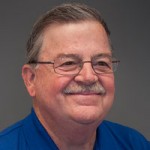 In a San Diego Union Tribune (UT) editorial in June, the newspaper said California could benefit greatly by enacting public pension reforms similar to those approved in Oregon this spring. The Oregon legislation regarding changes to the Oregon Public Employees Retirement System will reduce retirement benefits going forward for new and current employees, increase the workers’ contributions to help fund their pensions, and cap annual retirement pay at $195,000.
In a San Diego Union Tribune (UT) editorial in June, the newspaper said California could benefit greatly by enacting public pension reforms similar to those approved in Oregon this spring. The Oregon legislation regarding changes to the Oregon Public Employees Retirement System will reduce retirement benefits going forward for new and current employees, increase the workers’ contributions to help fund their pensions, and cap annual retirement pay at $195,000.
Readily showing its strong anti-public pension bias, the UT mischaracterizes the facts surrounding the “underfunding” of California’s public retirement funds, and also neglects to mention that the Oregon adjustments barely passed and will likely be challenged in court. The editorial writers suggest that California’s large retirement funds for government workers and teachers (CalPERS and CalSTRS) are “so underfunded” that Governor Gavin Newsom chose to shore them up with a $3 billion supplemental infusion in the current state budget. In fact, that approach is precisely what many local cities and counties are employing to address the future unfunded liabilities in their pension funds – budgeting extra payments now to reduce the debt and save on long-term interest expense.
This is a prudent business-like way to tackle the fiscal problem, not the desperate move aimed at pension systems in a “crisis” alluded to by the UT.
Like most American public retirement systems, the California plans are not 100% funded (CalPERS funded ratio has been reported as 68%; CalSTRS at 62.4%). Oregon’s funded status is reportedly 80%. And yet they don’t need to be fully capable today of meeting all benefits owed as long as they have long range strategies to meet those obligations when they are due. In 2012, California passed legislation reducing retirement benefit formulas for new hires after January 1, 2013, requiring workers to share equally with their employers (and taxpayers) in contributions to their pension fund, eliminating methods previously permitted of “spiking” pensions just before retirement, and placing limits on how high benefits could go.
The UT believes these reforms in California did not go far enough in reining in the cost of public pension benefits since the basic reductions only applied to new employees. The newspaper has previously embraced the idea that current workers should keep benefits already earned but receive lower retirement credits for the remainder of their public service careers, a prominent feature of the Oregon reforms.
Many public retirement systems have checkered histories, often enhancing pension benefits without adequately applying proper fiscal analysis and discipline to keep the plans healthy and viable. This includes both the Oregon pension system and the California plans. Also, all retirement plans were hammered by the 2008 stock market meltdown, which seriously affected pension funds and overall government tax revenues while benefits for public workers and retirees continued to grow. According to a New York Times article on the Oregon retirement system, it wasn’t until 2016 that average state tax collections recovered to pre-2008 levels.
There is obviously some truth to the opinion that the fiscal challenges of underfunding that face most traditional public pension plans were very often self-inflicted wounds. However, there are big differences in the approaches decision-makers and interested observers may promote to deal with the problem. In Oregon, Governor Kate Brown acknowledges that the Oregon system faces a looming crisis that needs to be addressed, but believes that all parties owe it to Oregon’s active and retired workers to keep the promises made and to protect retirement security and the state’s defined benefit system. The UT editorial board would be on the opposite end of the spectrum, arguing that public defined benefit pensions are too lucrative and unsustainable, and promoting a switch to 401(k) style savings accounts typically found in the private sector. ◾
 In Memory of Katherine “Kay” Ryan
In Memory of Katherine “Kay” Ryan
We’re sad to report the recent passing of a long-time friend of RESDC. Katherine “Kay” Ryan was a RESDC Board member from 2003 through 2006. She worked in the Fiscal Division of Health and Human Services and was in Middle Management Bargaining Unit. She worked for the County for 40 years and retired in 1999. Kay was president of SEIU, Local 2028 for six years and was involved in Salary Negotiations. She later became President of The Association of San Diego County Employees.
Kay was the Alternate Retired Member for Jim Feeley on The Board of Retirement from 2007 through 2010. She will be missed. ◾
Members Share
Joan Kalahiki
Environmental Health, Retired 1992.
 RESDC member, Joan Kalahiki, went to Oahu in the early 1950s as a nurse, married beachboy/musician Harry “Mungo” Kalahiki, and hung out with every surf legend during that time. “Wally Froiseth and George Downing gave me a surfing test, kind of like a driver’s license test, to make sure I could handle my board in the areas that I wanted to surf, like Queens and Publics.” Joan and her husband re-purposed balsa rafts into surfboards and sold them as fast as they could make them. “There wasn’t much opportunity to get balsa in Hawaii at that time, so we used what we had. The extra money sure helped feed our growing family, but the fiberglass in my nurse’s stockings was sheer torture.”
RESDC member, Joan Kalahiki, went to Oahu in the early 1950s as a nurse, married beachboy/musician Harry “Mungo” Kalahiki, and hung out with every surf legend during that time. “Wally Froiseth and George Downing gave me a surfing test, kind of like a driver’s license test, to make sure I could handle my board in the areas that I wanted to surf, like Queens and Publics.” Joan and her husband re-purposed balsa rafts into surfboards and sold them as fast as they could make them. “There wasn’t much opportunity to get balsa in Hawaii at that time, so we used what we had. The extra money sure helped feed our growing family, but the fiberglass in my nurse’s stockings was sheer torture.”
Said Joan, “I considered Makaha ‘my wave’, so I entered the contest along with my friend, Ethel Kukea. We surfed Hawaiian-style, and got beat by Marge Calhoun, who excelled in the California hot-dogging that was becoming popular right at that time.”
Joan worked for San Diego County in Environmental Health and Social Services until she retired in 1992. She will be 91 years old this summer. Joan now lives in Apache Junction, Arizona. ◾
 1958 Makaha Invitational line-up. Joan Kalahiki is #8, Ethel Kukea is #10, and winner, Marge Calhoun, is #6.
1958 Makaha Invitational line-up. Joan Kalahiki is #8, Ethel Kukea is #10, and winner, Marge Calhoun, is #6.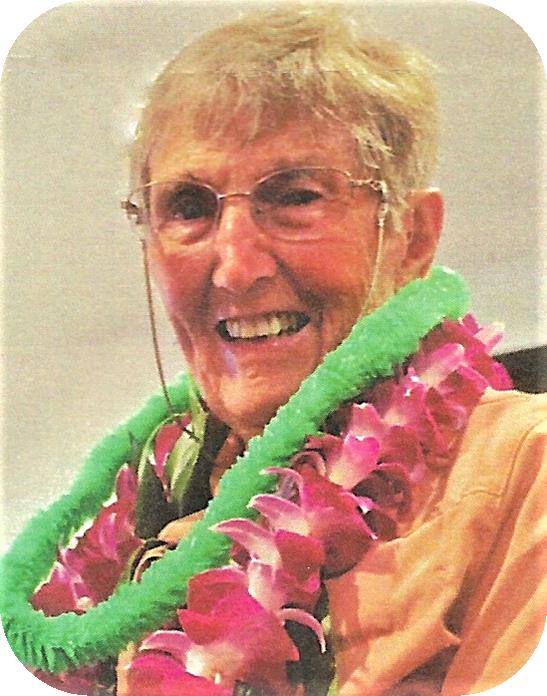 Joan Kalahiki at her 90th birthday party in 2018.
Joan Kalahiki at her 90th birthday party in 2018. Save the Date
Save the Date
2019 Coming Home Event
Thursday, October 3, 2019 at 11:00am
Location: Las Colinas Detention and Reentry Facility. 451 Riverview Parkway, Santee, CA 92071.
Watch for more details in the September & October NETWORKs. ◾
Bits and Pieces
Dorothy Baber celebrated her 99th birthday recently with a catered lunch attended by about 25 family members at her home in El Cajon. Dorothy retired in 1984 from Municipal Court. As she looks forward to celebrating the BIG 100, she plans to cruise to Alaska with her daughter, Vicki Owens, 2006 Animal Services retiree, where they will also celebrate Vicki’s 75th birthday.
Grace Larsen retired from North County Municipal Court in 1979. In June this year, she competed in women’s basketball in the 2019 National Senior Games in Albuquerque, New Mexico. The games are held every two years for those 50 years old and up. Grace is 93 years old and she was chosen to carry the California flag in the parade of athletes in the opening ceremonies. ◾
 Past Scholarship Recipients
Past Scholarship Recipients
Anya Athan received a RESDC Scholarship in 2016. She was sponsored by her father, Richard Athan. Anya is currently an honor student at The University of Wisconsin Milwaukee and is pursuing a career in medicine. She is also a member of the university’s track team.
Donald Kleinhen III earned a RESDC Scholarship in 2009. He was sponsored by his grandmother, Roma Stronach. Donald graduated from San Diego State University with a bachelor’s of science degree in Mechanical Engineering. After examining his job offers, he accepted an offer to work at Telaeris, Inc., where he had previously worked as an intern. He now serves as the systems engineer, designing mechanical and electrical systems as well as programming software. This summer he will fly to Australia to represent his company at an upcoming trade show.
“DIII” is an accomplished musician on piano, drums, bass, and guitar. On Sundays and special holidays, he provides the musical accompaniment at two local churches.
Evan Walker-Wells received a $2000 scholarship from RESDC in 2009 and matriculated to Yale University in the fall of that year. Evan was sponsored by his grandmother, Joan Wells. In January of 2010, Evan was diagnosed with non-Hodgkin Lymphoma, forcing him to take the spring semester off. Thankfully, after intensive treatment, he was able to return to Yale and received his degree Cum Laude, with distinction in the history major in 2014. Since that time he has founded a politically-oriented magazine called Scalawag, and has pursued journalistic writing. He has been accepted into his Alma Mater as a law student and will begin studies at the School of Law in the autumn of 2019. ◾
Recent Events
- New trustee appointed to Board of Retirement
The San Diego County Board of Supervisors voted unanimously to appoint Mark Hovey to the SDCERA Board of Retirement for a three-year term, beginning July 1, 2019. Hovey fills the appointed seat vacated by Mark Oemcke, who served two terms on the Board. In January 2018, Mr. Hovey retired as Chief Executive Officer of the San Diego City Employees’ Retirement System (SDCERS), an $8 billion, 20,000 Member trust fund administered for the City of San Diego, the San Diego Unified Port District, and the San Diego County Regional Airport Authority. - New Research – Women, Marriage, and the National Retirement Risk Index
The Center for Retirement Research at Boston College has released a brief which uses the National Retirement Risk Index (NRRI) to assess the retirement security of women in their 50s. The NRRI is calculated by comparing households’ projected replacement rates – retirement income as a percentage of pre-retirement income – with target replacement rates that would allow them to maintain their standard of living.The brief’s key findings include:
- Women are spending a growing share of their lives single, so it is useful to consider how their marital history affects their retirement preparedness.
- While married women have much higher household earnings and wealth, they are more at risk of failing to maintain their standard of living in retirement.
To access the research, visit: https://crr.bc.edu/category/briefs/. ◾
Board Member Profile
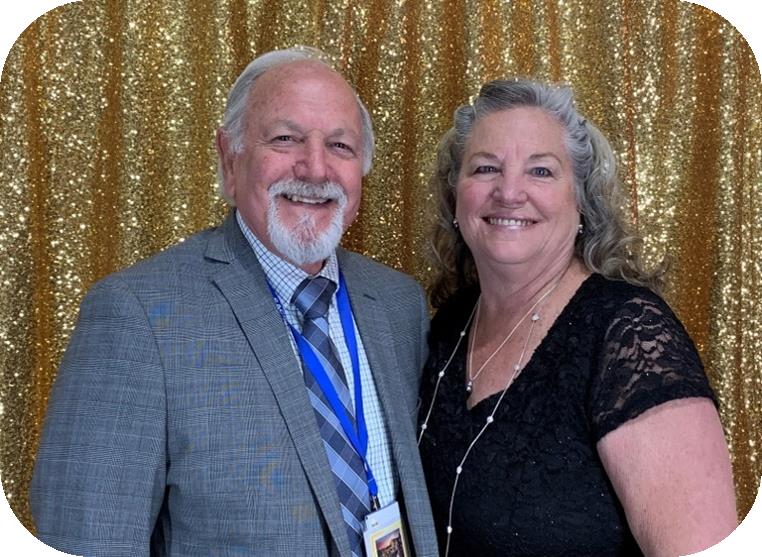 A member of the RESDC Board of Directors since December 2013, John retired from the General Services Department in 2007 with 23.5 years of county service. He became RESDC President in January 2016. His County experience also included years with Health and Human Services Agency, Office of Management and Budget, Public Works Agency, and on the staff of a County Supervisor.
A member of the RESDC Board of Directors since December 2013, John retired from the General Services Department in 2007 with 23.5 years of county service. He became RESDC President in January 2016. His County experience also included years with Health and Human Services Agency, Office of Management and Budget, Public Works Agency, and on the staff of a County Supervisor.
John has also owned his own public affairs consulting firm. He earned both Bachelors and Masters degrees in Public Administration from San Diego State University. John taught public administration classes at SDSU for 28 years.
John and Teresa will celebrate their 50th anniversary this October. They have two children and four grandchildren.
Along with volunteer service with RESDC in retirement, John enjoys photography and travel, travel, travel. His favorite travel destinations have been Hawaii, Europe, Israel, and cruising anywhere. ◾
 County Employees Investment Club
County Employees Investment Club
The County Employee Investment Club is recruiting new members. Applicants may be active or retired county employees and their spouses or others as invited by club members. The club, which has been in existence since 1965, exists for the purpose of providing good principles for investing, with the objective of helping members to begin investing and to better manage their investments. The club meets monthly on the third Wednesday, at 6:00 pm, in the Harbor Room at the County Health Services Complex, 3851 Rosecrans Street. Interested persons are encouraged to attend two or more meetings prior to applying for membership. Further information is available by contacting Thomas Ilas (619) 444-1569 or John Melbourn (858) 279-4368. ◾
Save the Date
San Diego County Credit Union
Financial Wellness Wednesdays
 Understanding Credit Reports, Preventing Identity Theft, And Scams
Understanding Credit Reports, Preventing Identity Theft, And Scams
When: Wednesday, September 25, 2019, 9 am
Where: San Diego Workforce Partnership
9246 Lightwave Ave., San Diego, CA 92123
What: Join your SDCCU® representative for an informative session on credit reporting. You will also receive tools on correcting inaccuracies and how to avoid identity theft.
RSVP: For more information or to RSVP for this free event, contact Jake Turpin, Business Development Officer, at jturpin@sdccu.com or call: (858) 597-8684. ◾
RESDC Day at the Padres
Thursday, September 12, 12:40pm
San Diego Padres vs. Chicago Cubs
Tickets are Selling Fast!
 Ticket price is $54.00 per person. Petco Park is located at 100 Park Blvd., San Diego, 92101.
Ticket price is $54.00 per person. Petco Park is located at 100 Park Blvd., San Diego, 92101.
Tickets include a pre-game buffet with standard ballpark fare, served one hour before first pitch until one hour after first pitch, and soft drinks served from one hour before first pitch through the seventh inning.
Registration: A limited number of tickets are available on a first-come first-serve basis. Tickets will be mailed approximately two weeks prior to the event date.
Register by Phone: Call the RESDC Office at (619) 688-9229 during our hours of 9 am – 2 pm Mon-Fri.
Register Online: Go to www.resdc.net/events, click on the green “Register” button, and follow the steps. You will need to use the email associated with your member account. Click “Add guest” to add additional registrants for $54 each. To pay for yourself and guests, click “Pay Online” and pay with credit card.
For questions or assistance registering, contact us at (619) 688-9229 or resdc@resdc.net.
2019 Flag Day / Independence Day Luncheon
June 27th, Ronald Reagan Community Room in El Cajon
See more photos at https://www.resdc.net/photo-galleries/flag-day-lunch-2019/.
Welcome New Members
Ramin Abidi – Public Works
Maria V. Allen – Probation
Lupita Castro-Zumga – Health & Human Services
Caesar J. Cuesta – Assessor Recorder County Clerk
Celia L. Engelman – Health & Human Services
Michael Fink
John Fulan – Health & Human Services
Regidor F. Garduno – Sheriff
Richard J. Henegar
Brenda S. Henson – Health & Human Services
Diana C. Hildreth – Health & Human Services
Alison Hunter
Sonia Martinez – Health & Human Services
Magdalena Morachis – Health & Human Services
Loreto N. Negado – Health & Human Services
Dawn R. Parker
Linda T. Perry – Health & Human Services
Maria T. Pugal – Superior Court
Flocerfida K. Roberts – Health & Human Services
Abderrazaq Sbili – Environmental Health
Cathy J. Wilson – District Attorney
Laurie A. Wootten – Assessor Recorder County Clerk
Marylynn M. Wright – Library
The surviving Spouse of a member is eligible for RESDC membership. For enrollment assistance, please call: (866) 688-9229. ◾
NETWORK is the official monthly newsletter of the Retired Employees of San Diego County, Inc. (RESDC), a private non-profit organization.
The information printed in the NETWORK is believed to be from reliable sources. However, no responsibility is assumed by the NETWORK for inaccuracies contained herein.
Business and Inquiries: Business matters and address changes may be recorded on our voicemail at any time, call (866) 688-9229. Please spell your name so the correct member record can be located.
Retired Employees of San Diego County, Inc.
8825 Aero Drive, Suite 205 | San Diego, CA 92123
Office Hours: 9 a.m. to 2 p.m. Monday through Friday
TELEPHONE: (866) 688-9229 Toll Free
FAX: (619) 688-0766
E-MAIL: resdc@resdc.net



